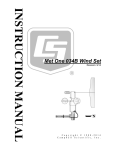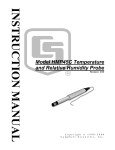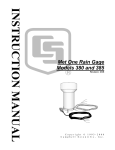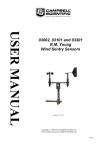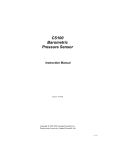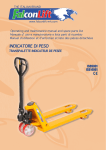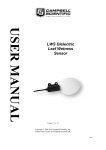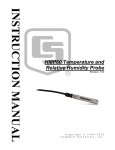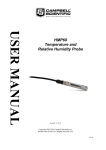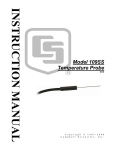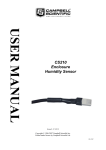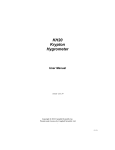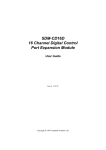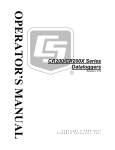Download Campbell Met One 034A-L Specifications
Transcript
Met One 034B Windset Revision: 1/11 N C o p y r i g h t © 1 9 8 0 - 2 0 1 1 C a m p b e l l S c i e n t i f i c , I n c . Warranty and Assistance The MET ONE 034B WINDSET is warranted by Campbell Scientific, Inc. to be free from defects in materials and workmanship under normal use and service for twelve (12) months from date of shipment unless specified otherwise. Batteries have no warranty. Campbell Scientific, Inc.'s obligation under this warranty is limited to repairing or replacing (at Campbell Scientific, Inc.'s option) defective products. The customer shall assume all costs of removing, reinstalling, and shipping defective products to Campbell Scientific, Inc. Campbell Scientific, Inc. will return such products by surface carrier prepaid. This warranty shall not apply to any Campbell Scientific, Inc. products which have been subjected to modification, misuse, neglect, accidents of nature, or shipping damage. This warranty is in lieu of all other warranties, expressed or implied, including warranties of merchantability or fitness for a particular purpose. Campbell Scientific, Inc. is not liable for special, indirect, incidental, or consequential damages. Products may not be returned without prior authorization. The following contact information is for US and International customers residing in countries served by Campbell Scientific, Inc. directly. Affiliate companies handle repairs for customers within their territories. Please visit www.campbellsci.com to determine which Campbell Scientific company serves your country. To obtain a Returned Materials Authorization (RMA), contact Campbell Scientific, Inc., phone (435) 753-2342. After an applications engineer determines the nature of the problem, an RMA number will be issued. Please write this number clearly on the outside of the shipping container. Campbell Scientific's shipping address is: CAMPBELL SCIENTIFIC, INC. RMA#_____ 815 West 1800 North Logan, Utah 84321-1784 For all returns, the customer must fill out a “Declaration of Hazardous Material and Decontamination” form and comply with the requirements specified in it. The form is available from our website at www.campbellsci.com/repair. A completed form must be either emailed to [email protected] or faxed to 435-750-9579. Campbell Scientific will not process any returns until we receive this form. If the form is not received within three days of product receipt or is incomplete, the product will be returned to the customer at the customer’s expense. Campbell Scientific reserves the right to refuse service on products that were exposed to contaminants that may cause health or safety concerns for our employees. Met One 034B Table of Contents PDF viewers note: These page numbers refer to the printed version of this document. Use the Adobe Acrobat® bookmarks tab for links to specific sections. 1. General .........................................................................1 2. Specifications ..............................................................1 3. Installation....................................................................2 3.1 Siting.........................................................................................................2 3.2 Assembly and Mounting...........................................................................2 4. Wiring............................................................................4 5. Programming ...............................................................5 5.1 5.2 5.3 5.4 Wind Speed ..............................................................................................5 Wind Direction .........................................................................................6 Wind Vector Processing Instruction.........................................................6 Example Programs....................................................................................7 5.4.1 CR1000 Example Program .............................................................7 5.4.2 CR10X Example Program ..............................................................8 5.5 Long Lead Lengths...................................................................................9 5.5.1 Sample CR10(X) Program when Long Leads are Required .........10 6. Sensor Maintenance..................................................11 7. Troubleshooting ........................................................11 7.1 Wind Direction .......................................................................................11 7.2 Wind Speed ............................................................................................12 8. References .................................................................12 Appendices A. Wind Direction Sensor Orientation........................ A-1 A.1 Determining True North and Sensor Orientation................................ A-1 B. Wind Direction Measurement Theory.................... B-1 C. Met One Instruments’ 034B Operation Manual..... C-1 i Met One 034B Table of Contents Figures 3-1. 034B Mounted on a Crossarm Using a 17953 NU-RAIL Crossover Fitting .................................................................................................. 3 3-2. CM200 Series Crossarm with CM220 Right Angle Mounting Bracket..... 4 A-1. Magnetic Declination for the Contiguous United States ................... A-2 A-2. Declination Angles East of True North are Subtracted From 0 to Get True North ............................................................................ A-2 A-3. Declination Angles West of True North are Added to 0 to Get True North ............................................................................ A-3 B-1. 034B Potentiometer in a Half Bridge Circuit..................................... B-1 Tables 1-1. 4-1. 5-1. 5-2. 5-3. 5-4. Recommended Cable Lengths ................................................................ 1 Connections to Campbell Scientific Dataloggers ................................... 4 Wind Speed Multiplier ........................................................................... 6 Parameters for Wind Direction............................................................... 6 Wiring for Example Programs................................................................ 7 Multiplier and Offset for Wind Direction when using Lead Lengths Greater than 100 Feet .......................................................................... 9 ii Met One 034B Windset 1. General The 034B Windset is used to measure horizontal wind speed and direction. Wind speed is measured with a three cup anemometer. Rotation of the cup wheel opens and closes a reed switch at a rate proportional to wind speed. Vane position is transmitted by a 10K ohm potentiometer. With a precision excitation voltage applied, the output voltage is proportional to wind direction. The accompanying Met One manual contains additional information on the operating principals, installation, and maintenance of the sensor. Cable length for the 034B is specified when the sensor is ordered. Table 1-1 gives the recommended cable length for mounting the sensor at the top of the tripod/tower with a CM202 crossarm. TABLE 1-1. Recommended Cable Lengths CM6 CM10 CM110 CM115 CM120 UT10 UT20 UT30 11’ 14’ 14’ 19’ 24’ 14’ 24’ 37’ The 034B Windset ships with: (1) 1/16” Allen wrench (1) Bushing from Met One (1) Calibration Sheet (3) Direction hub stickers (1) Resource CD (1) Wind Vane (1) Sensor cable of user-specified length 2. Specifications Wind Speed Operating Range: 0 to 75 m s-1 (0 to 167 mph) Threshold: 0.4 m s-1 (0.9 mph) Accuracy: ±0.12 m s-1 (±0.25 mph) for wind speed < 10.1 m s-1 (22.7 mph) ±1.1% of reading for wind speeds > 10.1 m s-1 (22.7 mph) Output Signal: contact closure (reed switch) Resolution: (1.789 mph) / (scan rate in seconds) or (0.7998 m s-1) / (scan rate in seconds) 1 Met One 034B Windset Wind Direction Measurement Range: 0 to 360° Threshold: 0.4 m s-1 (0.9 mph) Accuracy: ±4° Resolution: 0.5° Potentiometer Resistance: 0 to 10 kΩ open at crossover General Specifications Operating Temperature Range: -30° to +70°C Weight: 907 g (2.0 lb.) NOTE The black outer jacket of the cable is Santoprene® rubber. This compound was chosen for its resistance to temperature extremes, moisture, and UV degradation. However, this jacket will support combustion in air. It is rated as slow burning when tested according to U.L. 94 H.B. and will pass FMVSS302. Local fire codes may preclude its use inside buildings. 3. Installation 3.1 Siting Locate wind sensors away from obstructions (e.g. trees and building). As a general rule of thumb there should be a horizontal distance of at least ten times the height of the obstruction between the windset and the obstruction. If it is necessary to mount the sensors on the roof of a building, the height of the sensors, above the roof, should be at least 1.5 times the height of the building. See Section 8 for a list of references that discuss siting wind speed and direction sensors. 3.2 Assembly and Mounting Tools Required: • • • • • • • 1/2” open end wrench (for CM220) 5/64” and 1/16” Allen wrenches compass and declination angle for the site (see Appendix A) small screw driver provided with datalogger UV resistant cable ties small pair of diagonal-cutting pliers 6 - 10” torpedo level The wind vane tail must be attached to the hub. Install the tail assembly with the tail vertical. After tightening the set screw in the side of the hub that fastens the tail, cover the set screw hole with one of the small round labels included with the 034B. One of these labels is already installed on the hub covering the set screw that attaches the hub to the sensor. Extra labels are included with the 034B to recover the holes if the sensor has to be disassembled for maintenance. 2 Met One 034B Windset CAUTION The set screw holes must be covered with the labels to prevent corrosion and assure the warranty. Mount the CM200-series crossarm to the tripod or tower. Orient the crossarm North-South, with the 1” NU-RAIL or CM220 on the North end. Remove the alignment screw at the base of the 034B (Figure 3-1). Insert the 034B into the aluminum bushing provided with the sensor. Align the hole in the bushing with that in the 034B base and replace the screw. Insert the 034B/bushing into the NU-RAIL fitting or the CM220’s u-bolt (Figure 3-2). Align the sensor so that the counter weight points to true south and tighten the set screws on the NU-RAIL or U-bolts on the CM220. Remove the shoulder screw to allow the vane to rotate. Appendix A contains detailed information on determining true north using a compass and the magnetic declination for the site. Set screw holes must be covered with labels Shoulder Screw Alignment Screw Bushing N Crossarm 17953 NU-RAIL FIGURE 3-1. 034B Mounted on a Crossarm Using a 17953 NU-RAIL Crossover Fitting 3 Met One 034B Windset CM220 CM200 Series Crossarm FIGURE 3-2. CM200 Series Crossarm with CM220 Right Angle Mounting Bracket Attach the sensor cable to the six pin male connector on the 034B. Make sure the connector is properly keyed. Finger tighten the knurled ring. Route the sensor cable along the underside of the crossarm to the tripod/tower, and to the instrument enclosure. Secure the cable to the crossarm and tripod/tower using cable ties. 4. Wiring Connections to Campbell Scientific dataloggers are given in Table 4-1. When Short Cut for Windows software is used to create the datalogger program, the sensor should be wired to the channels shown on the wiring diagram created by Short Cut. TABLE 4-1. Connections to Campbell Scientific Dataloggers 4 Color Wire Label CR800 CR5000 CR3000 CR1000 Red WS Signal Pulse Black WS Signal Ref Green WD Signal SE Analog SE Analog SE Analog SE Analog Blue WD Volt Excite Excitation (VX) Excitation Excitation Excitation (VX) White WD Signal Ref AG Clear Shield G CR510 CR500 CR10(X) 21X CR7 CR23X CR200(X) Pulse Pulse P_LL G Met One 034B Windset The CR10X, CR23X, and dataloggers programmed with CRBasic can also measure wind speed on a control port. With this option the black wire is connected to the 5 V terminal. CONNECTOR PIN-OUT 3 4 2 6 5 1 PIN 1 - AZIMUTH SIGNAL PIN 2 - AZIMUTH REFERENCE PIN 3 - AZIMUTH EXCITATION PIN 4 - PULSE OUT PIN 5 - PULSE REFERENCE PIN 6 - SHIELD NOTE 034B-L Windsets purchased directly from Met One Instruments have a different configuration on the 6 pin connector. In addition, they do not have the 10 kΩ resistance on the excitation line. The wiring diagram and the multiplier and offset, for wind direction, are different than the examples in this document. 5. Programming This section is for users who write their own programs. A datalogger program to measure this sensor can be created using Campbell Scientifics’ Short Cut Program Builder software. You do not need to read this section to use Short Cut. 5.1 Wind Speed Wind speed is measured with the Pulse Count instruction, using the Switch Closure configuration and set to output frequency in Hertz (see Section 5.4 for examples). The expression for wind speed (U) is: U = MX + B where M = multiplier X = number of pulses per second (Hertz) B = offset Table 5-1 lists the multipliers (M) and offsets (Off) to obtain meters/second or miles/hour when the Pulse Count instruction is configured to output the result in Hz. 5 Met One 034B Windset TABLE 5-1. Wind Speed Multiplier* Model 034B Meters/Second Miles/Hour M = 0.7989 M = 1.787 Off = 0.28 Off = 0.63 *When configured to output counts, the multiplier above is divided by the execution interval in seconds. 5.2 Wind Direction The CR200(X) dataloggers use the ExDelSE instruction to measure wind direction. All other CRBasic dataloggers (e.g., CR800, CR1000, CR3000, CR5000) use the BRHalf instruction (see Section 5.4.1 for example). Edlog dataloggers (CR510, CR10(X), CR23X) typically use Instruction 5 – AC Half Bridge (P5) to measure wind speed (see Section 5.4.2 for example). When the sensor cable length is greater than 100 ft, Edlog Instruction 4 – Excite-Delay (P4) is recommended instead (see Section 5.5). Excitation voltages, range codes, and multipliers for our dataloggers are listed in Table 5-2. The multiplier value converts the sensor’s millivolt output to degrees. Appendix B has additional information on the measurement instructions. TABLE 5-2. Parameters for Wind Direction CR7 21X CR23X CR10(X) CR510 CR800 CR1000 CR5000 CR3000 CR200(X) Measurement Range, Integration 2500 mV, slow 5000 mV, slow/60 Hz 2500 mV, 60 Hz, reverse excitation 5000 mV, 60 Hz, reverse excitation N/A Excitation Voltage 2500 mV 5000 mV 2500 mV 5000 mV 2500 mV Multiplier 720* 720* 720 720 0.288 Offset 0 0 0 0 0 *The multiplier for the Edlog dataloggers assumes Edlog Instruction 5 – AC Half Bridge is used. Refer to Section 5.5 if using Edlog Instruction 4 – Excite-Delay. 5.3 Wind Vector Processing Instruction The Wind Vector output instruction is used to process and store mean wind speed, unit vector mean wind direction, and Standard Deviation of the wind direction (optional) from the measured wind speed and direction values. 6 Met One 034B Windset 5.4 Example Programs The following programs measure the 034B every 5 seconds, and store mean wind speed, unit vector mean direction, and standard deviation of the direction every 60 minutes. Wiring for the examples is given in Table 5-3. TABLE 5-3. Wiring for Example Programs Color Description CR1000 CR10X Red Wind Spd. Signal P1 P1 Black Wind Spd. Reference Green Wind Dir. Signal SE 1 SE 1 Blue Wind Dir. Excitation EX 1 E1 White Wind Dir. Reference AG Clear Wind Dir. Shield G G 5.4.1 CR1000 Example Program 'CR1000 'Declare Variables and Units Public Batt_Volt Public WS_ms Public WindDir Units Batt_Volt=Volts Units WS_ms=meters/second Units WindDir=degrees 'Define Data Tables DataTable(Table1,True,-1) DataInterval(0,60,Min,10) WindVector (1,WS_ms,WindDir,FP2,False,0,0,0) FieldNames("WS_ms_Avg,WindDir_Avg,WindDir_StDev") EndTable 'Main Program BeginProg Scan(5,Sec,1,0) 'Default Datalogger Battery Voltage measurement Batt_Volt: Battery(Batt_Volt) '034A/034B Wind Speed & Direction Sensor measurements WS_ms and WindDir: PulseCount(WS_ms,1,1,2,1,0.799,0.2811) If WS_ms=0.2811 Then WS_ms=0 BrHalf(WindDir,1,mV2500,1,1,1,2500,True,0,_60Hz,720.0,0) If WindDir>=360 OR WindDir < 0 Then WindDir=0 'Call Data Tables and Store Data CallTable(Table1) NextScan EndProg 'Use 5000 mV 'excitation for 'the CR3000 and 'CR5000 dataloggers 7 Met One 034B Windset 5.4.2 CR10X Example Program ;{CR10X} *Table 1 Program 01: 5.0000 Execution Interval (seconds) 1: Pulse (P3) 1: 1 2: 1 3: 22 4: 3 5: 0.799 6: 0.2811 Reps Pulse Channel 1 Switch Closure, Output Hz Loc [ WS_ms ] Multiplier Offset 2: If (X<=>F) (P89) 1: 3 X Loc [ WS_ms 2: 1 = 3: 0.2811 F 4: 30 Then Do ] 3: Z=F x 10^n (P30) 1: 0 F 2: 0 n, Exponent of 10 3: 3 Z Loc [ WS_ms ] 4: End (P95) 5: AC Half Bridge (P5) 1: 1 Reps 2: 25 2500 mV 60 Hz Rejection Range 3: 1 SE Channel 4: 1 Excite all reps w/Exchan 1 5: 2500 mV Excitation 6: 4 Loc [ WindDir ] 7: 720 Multiplier 8: 0.0 Offset 6: If (X<=>F) (P89) 1: 4 X Loc [ WindDir ] 2: 3 >= 3: 360 F 4: 30 Then Do 7: Z=F x 10^n (P30) 1: 0 F 2: 0 n, Exponent of 10 3: 4 Z Loc [ WindDir ] 8: End (P95) 9: If time is (P92) 1: 0 Minutes (Seconds --) into a 2: 60 Interval (same units as above) 3: 10 Set Output Flag High (Flag 0) 8 ; 5000 mV(slow/60 hz) for CR23X, 21X ; 5000 mV for CR23X, 21X, CR7 Met One 034B Windset 10: Set Active Storage Area (P80) 1: 1 Final Storage Area 1 2: 101 Array ID 11: Real Time (P77) 1: 1220 Year,Day,Hour/Minute (midnight = 2400) 12: Wind Vector (P69) 1: 1 Reps 2: 0 Samples per Sub-Interval 3: 0 S, theta(1), sigma(theta(1)) with polar sensor 4: 3 Wind Speed/East Loc [ WS_ms ] 5: 4 Wind Direction/North Loc [ WindDir ] 5.5 Long Lead Lengths When sensor lead length exceeds 100 feet, the settling time allowed for the measurement of the vane should be increased to 20 milliseconds. For dataloggers programmed with CRBasic, increase the “Settling Time” parameter of the CRBasic instruction to 20 milliseconds (20,000 microseconds). Dataloggers programmed with Edlog should use Instruction 4 – Excite-Delay (P4), rather than Instruction 5 – AC Half Bridge (P5). Enter a 2 in the Delay parameter for a 20 millisecond delay. With a CR510 or CR10(X), use a 2500 mV excitation and the 2500 mV measurement range. With a 21X, CR7, or CR23X, use a 5000 mV excitation and the 5000 mV measurement range. CAUTION The 60 Hz rejection option can not be used with the DC Half Bridge instruction, when the delay is not zero. Do not use long lead lengths in electrically noisy environments. TABLE 5-4. Multiplier and Offset for Wind Direction when using Lead Lengths Greater than 100 Feet Datalogger Type Instruction Number Multiplier Offset degrees CR10(X) CR510 4 0.288 0 degrees CR23X CR7, 21X 4 0.144 0 Units 9 Met One 034B Windset 5.5.1 Sample CR10(X) Program when Long Leads are Required ;{CR10X} ; *Table 1 Program 01: 10 Execution Interval (seconds) 01: Pulse (P3) 1: 1 2: 2* 3: 22 4: 1* 5: 0.7990 6: 0.2811 Reps Pulse Channel 2 Switch Closure, Output Hz Loc [ WndS_m_s ] Mult Offset ;Set the wind speed to zero if the wind is not blowing. ; 02: If (X<=>F) (P89) 1: 1* X Loc [ WndS_m_s ] 2: 1 = 3: 0.2811 F 4: 30 Then Do 03: Z=F (P30) 1: 0 2: 0 3: 1* F Exponent of 10 Z Loc [ WndS_m_s ] 04: End (P95) 05: Excite-Delay (SE) (P4) 1: 1 Reps 2: 5** ± 2500 mV Slow Range 3: 5* SE Channel 4: 3* Excite all reps w/Exchan 3 5: 2 Delay (units 0.01 sec) 6: 2500** mV Excitation 7: 2* Loc [ WndD_deg ] 8: 0.288 Mult 9: 0 Offset 06: If time is (P92) 1: 0 Minutes (Seconds --) into a 2: 30 Interval (same units as above) 3: 10 Set Output Flag High (Flag 0) 07: Real Time (P77) 1: 0110 Day,Hour/Minute 10 Met One 034B Windset 08: Wind Vector (P69) 1: 1 Reps 2: 0 Samples per Sub-Interval 3: 00 S, θu, & σ(θu) Polar*** 4: 1* Wind Speed [ WndS_m_s ] 5: 2* Wind Direction [ WndD_deg ] -Input Locations1 WndS_m_s 2 WndD_deg * Proper entries will vary with program and datalogger channel and input location assignments. ** On the 21X use the 5000 mV input range and the a 5000 mV excitation voltage. *** Average wind speed, average unit vector wind direction, standard deviation of unit vector wind direction 6. Sensor Maintenance 1 Month • Do a visual/audio inspection of the anemometer at low wind speeds. Verify that the cup assembly and wind vane rotate freely. Inspect the sensor for physical damage. Verify cups and vane are tight. 6 Months • Replace anemometer bearings if operating under harsh conditions 1 Year • Replace anemometer bearings. Contact Campbell Scientific for a Return Materials Authorization (RMA) number at (801) 753-2342. 2 Years • Replace the wind vane potentiometer and bearings. Contact Campbell Scientific for a Return Materials Authorization (RMA) number at (801) 753-2342. 7. Troubleshooting 7.1 Wind Direction Symptom: -9999 or no change in direction 1. Check that the sensor is wired to the Excitation and Single-Ended channel specified by the measurement instruction. 2. Verify that the excitation voltage and Range code are correct for the datalogger type. 3. Disconnect the sensor from the datalogger and use an ohm meter to check the potentiometer. Resistance should be vary from 11K to 21K ohms between the blue and green wires depending on vane position. Resistance should be vary from 1K to 11K ohms between the white and green wires depending on vane position. 11 Met One 034B Windset Symptom: Incorrect wind direction 1. Verify that the Excitation voltage, Range code, multiplier and offset parameters are correct for the datalogger type. 2. Check orientation of sensor as described in Section 3. 7.2 Wind Speed Symptom: No wind speed 1. Check that the sensor is wired to the Pulse channel specified by the Pulse count instruction. 2. Disconnect the sensor from the datalogger and use an ohm meter to check the reed switch. The resistance between the red and black wires should vary from infinite (switch open) to less than 1 ohm (switch closed) as the cupwheel is slowly turned. 3. Verify that the Configuration Code (Switch Closure, hertz), and Multiplier and Offset parameters for the Pulse Count instruction are correct for the datalogger type. Symptom: Wind speed does not change 1. For the dataloggers that are programmed with Edlog, the input location for wind speed is not updated if the datalogger is getting “Program Table Overruns”. Increase the execution interval (scan rate) to prevent overruns. 8. References The following references give detailed information on siting wind speed and wind direction sensors. EPA, 1989: Quality Assurance Handbook for Air Pollution Measurements System, Office of Research and Development, Research Triangle Park, NC, 27711. EPA, 1987: On-Site Meteorological Program Guidance for Regulatory Modeling Applications, EPA-450/4-87-013, Office of Air Quality Planning and Standards, Research Triangle Park, NC 27711. The State Climatologist, 1985: Publication of the American Association of State Climatologists: Height and Exposure Standards, for Sensors on Automated Weather Stations, vol. 9, No. 4. WMO, 1983: Guide to Meteorological Instruments and Methods of Observation, World Meteorological Organization, No. 8, 5th edition, Geneva, Switzerland. 12 Appendix A. Wind Direction Sensor Orientation A.1 Determining True North and Sensor Orientation Orientation of the wind direction sensor is done after the datalogger has been programmed, and the location of True North has been determined. True North is usually found by reading a magnetic compass and applying the correction for magnetic declination; where magnetic declination is the number of degrees between True North and Magnetic North. Magnetic declination for a specific site can be obtained from a USGS map, local airport, or through a computer service offered by the USGS at www.ngdc.noaa.gov/geomag. A general map showing magnetic declination for the contiguous United States is shown in Figure A-1. Declination angles east of True North are considered negative, and are subtracted from 0 degrees to get True North as shown Figure A-2. Declination angles west of True North are considered positive, and are added to 0 degrees to get True North as shown in Figure A-3. For example, the declination for Logan, Utah is 14° East. True North is 360° - 14°, or 346° as read on a compass. Orientation is most easily done with two people, one to aim and adjust the sensor, while the other observes the wind direction displayed by the datalogger. 1. Establish a reference point on the horizon for True North. 2. Sighting down the instrument center line, aim the nose cone, or counterweight at True North. Display the input location or variable for wind direction using a hand-held keyboard display, PC, or palm. 3. Loosen the u-bolt on the CM220 or the set screws on the Nu-Rail that secure the base of the sensor to the crossarm. While holding the vane position, slowly rotate the sensor base until the datalogger indicates 0 degrees. Tighten the set screws. A-1 Appendix A. Wind Direction Sensor Orientation Subtract declination from 360° Add declination to 0° 20 W 22 E 18 W 16 W 20 E 14 W 12 W 18 E 10 W 8 W 16 E 6 W 4 W 14 E 2 W 0 12 E 10 E 8 E 6 E 4 E 2 E FIGURE A-1. Magnetic Declination for the Contiguous United States FIGURE A-2. Declination Angles East of True North Are Subtracted From 0 to Get True North A-2 Appendix A. Wind Direction Sensor Orientation FIGURE A-3. Declination Angles West of True North Are Added to 0 to Get True North A-3 Appendix A. Wind Direction Sensor Orientation A-4 Appendix B. Wind Direction Measurement Theory It is not necessary to understand the concepts in this section for the general operation of the 034B Windset with Campbell Scientific’s datalogger. The 034B Windsets purchased from Campbell Scientific have a 9.53 kΩ fixed resistor and a variable resistor on the excitation line. The variable resistor is adjusted by the manufacturer so its resistance plus the 9.53 k resistor equals the resistance of the potentiometer (Rf = Rs + Rt). R = 9.53K OHM f V ADJUSTABLE RESISTANCE TO BALANCE POTENTIOMETER x R t 1K OHM V 10K OHM POTENTIOMETER s R s AG or FIGURE B-1. 034B Potentiometer in a Half Bridge Circuit The vanes are calibrated due south and then the potentiometer is adjusted until each half of the potentiometer has equal resistance. B-1 Appendix B. Wind Direction Measurement Theory B-2 Appendix C. Met One Instruments’ 034B Operation Manual This appendix contains a copy of Met One Instruments’ 034B Operation Manual. Campbell Scientific cannot guarantee that the information contained in their manual is current. For the latest information, please refer to Met One Instruments’ website (www.metone.com). C-1 Appendix C. Met One Instruments’ 034B Operation Manual C-2 Appendix C. Met One Instruments’ 034B Operation Manual C-3 Appendix C. Met One Instruments’ 034B Operation Manual C-4 Appendix C. Met One Instruments’ 034B Operation Manual C-5 Appendix C. Met One Instruments’ 034B Operation Manual C-6 Appendix C. Met One Instruments’ 034B Operation Manual C-7 Appendix C. Met One Instruments’ 034B Operation Manual C-8 Appendix C. Met One Instruments’ 034B Operation Manual C-9 Appendix C. Met One Instruments’ 034B Operation Manual C-10 Appendix C. Met One Instruments’ 034B Operation Manual C-11 Appendix C. Met One Instruments’ 034B Operation Manual C-12 Appendix C. Met One Instruments’ 034B Operation Manual C-13 Appendix C. Met One Instruments’ 034B Operation Manual C-14 Appendix C. Met One Instruments’ 034B Operation Manual C-15 Appendix C. Met One Instruments’ 034B Operation Manual C-16 Appendix C. Met One Instruments’ 034B Operation Manual C-17 Appendix C. Met One Instruments’ 034B Operation Manual C-18 Campbell Scientific Companies Campbell Scientific, Inc. (CSI) 815 West 1800 North Logan, Utah 84321 UNITED STATES www.campbellsci.com • [email protected] Campbell Scientific Africa Pty. Ltd. (CSAf) PO Box 2450 Somerset West 7129 SOUTH AFRICA www.csafrica.co.za • [email protected] Campbell Scientific Australia Pty. Ltd. (CSA) PO Box 444 Thuringowa Central QLD 4812 AUSTRALIA www.campbellsci.com.au • [email protected] Campbell Scientific do Brazil Ltda. (CSB) Rua Luisa Crapsi Orsi, 15 Butantã CEP: 005543-000 São Paulo SP BRAZIL www.campbellsci.com.br • [email protected] Campbell Scientific Canada Corp. (CSC) 11564 - 149th Street NW Edmonton, Alberta T5M 1W7 CANADA www.campbellsci.ca • [email protected] Campbell Scientific Centro Caribe S.A. (CSCC) 300 N Cementerio, Edificio Breller Santo Domingo, Heredia 40305 COSTA RICA www.campbellsci.cc • [email protected] Campbell Scientific Ltd. (CSL) Campbell Park 80 Hathern Road Shepshed, Loughborough LE12 9GX UNITED KINGDOM www.campbellsci.co.uk • [email protected] Campbell Scientific Ltd. (France) Miniparc du Verger - Bat. H 1, rue de Terre Neuve - Les Ulis 91967 COURTABOEUF CEDEX FRANCE www.campbellsci.fr • [email protected] Campbell Scientific Spain, S. L. Avda. Pompeu Fabra 7-9, local 1 08024 Barcelona SPAIN www.campbellsci.es • [email protected] Please visit www.campbellsci.com to obtain contact information for your local US or International representative.










































